Manuscript accepted on : 06/08/2020
Published online on: 08-08-2020
Plagiarism Check: Yes
Reviewed by: Hadi Rasha
![]()
Second Review by: Ruchi Verma
![]()
Final Approval by: Dr. Haseeb Ahmad Khan ![]()
Kohl: A Widely used eye Cosmetic with Hazardous Biochemical Composition.
Erum Buksh1, Sehar Afshan Naz1 , Arif Zubair2*, Kousar Yasmeen3, Maryam Shafique1, Nusrat Jabeen4
, Arif Zubair2*, Kousar Yasmeen3, Maryam Shafique1, Nusrat Jabeen4 ![]() and Muhammad Hamayun5
and Muhammad Hamayun5
![]()
1Department of Microbiology, Federal Urdu University of Arts, Science and Technology, Karachi, Pakistan
2Department of Environmental Sciences, Federal Urdu University of Arts, Science and Technology, Karachi, Pakistan
3Department of Chemistry, Federal Urdu University of Arts, Science and Technology, Karachi, Pakistan
4Department of Microbiology, University of Karachi, Karachi, Pakistan
5Department of Botany, Abdul Wali Khan University, Mardan, Pakistan
Corresponding Author E-mail : drarifzubair786@gmail.com
DOI : http://dx.doi.org/10.13005/bbra/2865
ABSTRACT: Kohl (Surma/Kajal) is a widely used eye cosmetic having traditional and religious importance in subcontinent and other parts of the world since ancient times. However, the use of Kohl has become hazardous for human health in recent times due to its changing compositions. In present study, we studied the antimicrobial potential of Kohl, presence of microbial pathogens and chemical contaminants in twenty Kohl samples collected from Karachi city, Pakistan. The samples included 85% branded and 15% unbranded Kohl samples. Our results showed that 75% of the samples possess higher antibacterial activity, while 30% of the samples showed antifungal potential. Moreover, pathogenic Bacillus and Aspergillus species were isolated from these Kohl samples as major microbial contaminants. Higher levels of arsenic, lead and cadmium were detected in 80%, 35% and 30% of the Kohl samples respectively, when compared against the standard limits. Current findings showed that presence of toxic metals and microbial pathogens in Kohl samples is hazardous for humans. Furthermore, Kohl shall not be used until the safe limits of carcinogenic metals and other contaminants in the Kohl are certified by the manufacturers.
KEYWORDS: Antimicrobial Activity; Biochemical Contaminants; Flame Atomic Absorption Spectrophotometer; Heavy metals; Kohl
Download this article as:| Copy the following to cite this article: Buksh E, Naz S. A, Zubair A, Yasmeen K, Shafique M, Jabeen N, Hamayun M. Kohl: A Widely used eye Cosmetic with Hazardous Biochemical Composition. Biosci Biotech Res Asia 2020;17(3). |
| Copy the following to cite this URL: Buksh E, Naz S. A, Zubair A, Yasmeen K, Shafique M, Jabeen N, Hamayun M. Kohl: A Widely used eye Cosmetic with Hazardous Biochemical Composition. Biosci Biotech Res Asia 2020;17(3). Available from: https://bit.ly/2PHa5Cb |
Introduction
Kohl, also known as surma, surmi, kajal etc. has been considered as one of the ancient cosmetics which have been used by various civilizations since prehistoric times.1 The earliest use of Kohl as eyeliner was reported in the ancient Egypt and had great importance in Egyptians that even they buried Kohl containers alongside the dead bodies.2,3 Kohl has also got importance in Islam and its use is described as “Sunnah” in Abu DawudTib and TirmidhiTib. The use of Kohl Al-Ethmed before sleeping was recommended by Prophet Muhammad (Peace be upon Him) for enhanced vision and hair growth.4,5 Initially, the source of Kohl was a black stone “Ithmed”, composed of stibnite ore (Sb2S3), also known as Antimony which was believed to have beneficial aspects6. This stibnite ore was used alone as Kohl or used in combination with other ingredients such as camphor, menthol, almond seeds, wood essence, charcoal or other vegetable ashes. Later, stibnite ore was gradually replaced by the Galena ore (lead sulphide) which owns the same grey black colour and shiny appearance like stibnite7. However, the exact composition of Kohl has long been a matter of dispute within the scientific community.8
The beneficial potentials of Kohl have been proved by the studies that fully supported the medicinal benefits of the multiple ingredients found in the Kohl.9 Earlier, Kohl mixed with rose water was also reported to be instilled in the eyes by community people to treat smallpox pustules10. Kohl has also been used for keeping eyes cool and clean, also as a prevention from several eye diseases such as cataract, conjunctivitis, chalazion, trachoma and blepharitis. Moreover, there are some places in world with a common practice to apply Kohl on the umbilicus of newborns to help the healing process.11 The black and shiny particles of galena protected the eyes from the harmful effects of ultra violet radiations from sunlight and dust particles.12 Most of the ingredients such as different chemicals, herbs and gemstones are also added in Kohl because of their beneficial influence on the eyesight along with astringent, antibacterial and antiviral effects. Some plant extracts such as Coptisteeta, Fennel (Foeniculumvulgare) and Saffron (Crocus sativus) extracts were also used in the composition of Kohl and considered highly beneficial for improving weak eyesight and to fight against many eye diseases such as catarrhal and rheumatic conjunctivitis.2
Besides, Kohl has also gained a negative reputation after the use of galena stone as a major constituent rather than antimony ore, as it resulted in lead intoxication due to high content of lead in Kohl samples.13 Many studies have discouraged the use of Kohl due to its possible health hazards. The possible lead toxicity in eye cosmetic (Kohl) consumers was studied in California, where the users were mainly the children from Pakistan and India as their lead level was observed as 12.9 µg/dL while it was only 4.3 µg/dL among children not using Kohl cosmetics.14 However, certain studies also reported no association of increased blood lead level with application of Kohl.15 The contamination in Kohl samples with pathogenic bacterial and fungal strains has also been reported earlier as a reason of spreading ocular infections among many individuals.10
The objective of this study was conceived after the incident reported in Sydney (Australia) where three children got severely ill due to lead toxicity caused by regular use of Kohl.The current study was designed to conduct the microbiological and chemical analysis of the Kohl samples available in different local markets of Karachi City, Pakistan.
Materials and Methods
Collection of the Kohl Samples
A total of 20 samples (branded and non-branded) of the traditional Kohls were collected, randomly, from different local markets of Karachi city, and transported to the microbiology research laboratory, Federal Urdu University of Arts, Science and Technology (FUUAST) for further analysis.
Detection of Antimicrobial Potential of the Kohl Samples
Antimicrobial potential of different Kohl samples was detected against different bacterial and fungal reported pathogens of ocular infections, as mentioned below.
Antibacterial Potential of the Kohl Samples
The antibacterial effect of the Kohl samples was investigated against different clinical strains of three Gram-negative (K. pneumoniae, P. aeruginosaand P. mirabilis) and two Gram-positive bacteria (S. aureus and S. epidermidis), obtained from Lab of Applied Microbiology and Clinical Mycology, Department of Microbiology, FUUAST. The suspensions of kohl samples were prepared by adding one gram of kohl in 2 ml of sterile distilled water and vortexed well.The antibacterial activity of Kohl samples was assessed by Agar-well diffusion method 16.
Antifungal Potential of the Kohl Samples
Antifungal effect of the Kohl samples was investigated against pathogenic isolates reported for ocular infections, including two yeasts (C. albicansand C. tropicalis) and three molds (A. flavus, F. oxysporum, and Mucorsp.) obtained from Lab of Applied Microbiology and Clinical Mycology, Department of Microbiology, FUUAST. The suspensions of kohl samples were prepared by adding one gram of kohl in 2 ml of sterile distilled water and vortexed well. The antifungal activity of these Kohl samples was determined by Agar-well diffusion method17.
Isolation and Identification of Microorganism from Kohl Samples
For the isolation of microorganisms from the Kohl samples, a serial dilution of each Kohl sample was prepared up to 10-2 dilution and processed. Identification of the isolated bacterial and fungal colonies was done macroscopically by observing the color, texture and pigmentation of media by microorganisms, while microscopically by staining (Gram staining in case of bacteria and Lactophenol blue staining for fungi isolates), according to established protocol18.
Heavy Metal Analysis of the Kohl Samples
The chemical analysis of Kohl samples was carried out by Flame Atomic Absorption Spectrophotometer (FAAS) (Perkin Elmer-A Analyst 700). The Kohl samples were prepared for this analysis by using wet digestion method, and analyzed, in triplicate, for the estimation of trace metals including arsenic (As), cadmium (Cd), lead (Pb), copper (Cu), iron (Fe) and sodium (Na), using established protocol19. The results were expressed as mean ± SD and compared with BVL standards. According to BVL standards, toxic metals in cosmetic products such as arsenic, cadmium, lead, Mercury exceeding the values 0.5, 0.1, 0.1 and 5 ppm (mg/kg), respectively, should be avoided.20
Results
In current study, a total of 20 different Kohl (Surma) samples were purchased from different local markets in the Karachi city. Among these Kohl samples, 85% were branded while 15% were unbranded. These Kohl samples were available within the price range of 20 to 90 Pakistani rupees, manufactured locally or imported from India and Saudi Arabia.
The antimicrobial potentials of collected Kohl samples were tested against some clinically important pathogens, reported for causing predominant ocular infections. Amongst all, 75% of the total Kohl samples revealed good antibacterial activity. The highest activity was reported against P. mirabilis and S. epidermidis(Fig. 1& 3). Moreover, 30% of the samples demonstrated antagonistic potential against fungal pathogens. The highest activity was observed against Candida and Mucorsp. (Fig 2& 3).
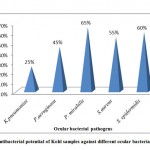 |
Figure 1: Antibacterial potential of Kohl samples against different ocular bacterial pathogens |
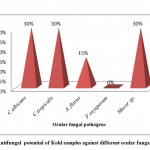 |
Figure 2: Antifungal potential of Kohl samples against different ocular fungal pathogens |
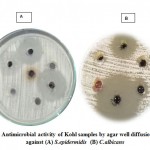 |
Figure 3: Antimicrobial activity of Kohl samples by agar well diffusion method against (A) S.epidermidis (B) C.albicans |
The microbial contamination in collected Kohl samples was also examined by spread plate method. Based on the colony forming unit (CFU), the samples were interpreted as contaminated or free from contamination. Bacterial contamination alone was found in 45% of the Kohl samples while contamination with fungi was observed in 15% of the samples. However, contamination with both bacteria and fungi was detected in 15% of the Kohl samples (Fig.4).
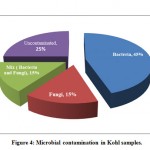 |
Figure 4: Microbial contamination in Kohl samples. |
Based on their morphological shape, visualized by Gram’s staining, the bacterial isolates were identified as rod shaped (Bacillus) bacteria, while fungal strains were identified as Aspergillusflavus and A. niger, on the basis of their microscopic as well as macroscopic characteristics.
The contamination of different heavy metals such as arsenic, cadmium, lead, copper, iron and sodium in the Kohl samples was analyzed by Flame Atomic Absorption Spectrophotometer (FAAS). The Kohl samples where metals were detected in Below Detection Limit (BDL) were declared as free from heavy metal contamination. Amongst lethal heavy metals (As, Cd and Pb), 90% of the Kohl samples were found contaminated with arsenic metal, however cadmium and lead contamination was detected in 65 and 40% of Kohl samples, respectively. Other than these metals, Cu, Fe and Na metals were also detected from these samples. Both the iron and sodium were detected in 95 to 100 % of the Kohl samples. The results showed complete absence of copper metal in all the Kohl samples (Table1 & Fig 5).
Table 1: Determination of heavy metals content (ppm*) in kohl samples
| Sample ID | Arsenic
Mean ± SD |
Cadmium
Mean ± SD |
Copper
Mean ± SD |
Iron
Mean ± SD |
Sodium
Mean ± SD |
Lead
Mean ± SD |
| SE1 | 0.244±0.1850 | 0.385±0.0010 | BDL** | 17.23±0.034 | 13.18±0.351 | 198.3±0.36 |
| SE2 | 1.184±0.3036 | 1.430±0.0008 | BDL | 18.71±0.006 | 16.29±0.087 | 199.9±0.40 |
| SE3 | 1.746±0.2779 | 0.298±0.0011 | BDL | 9.187±0.0476 | 15.71±0.028 | 195.0±0.10 |
| SE4 | 2.081±0.1886 | 0.277±0.0011 | BDL | 4.241±0.0061 | 9.592±0.1450 | 195.1±0.12 |
| SE5 | 2.592±0.1254 | 0.375±0.0022 | BDL | 16.43±0.041 | 28.00±5.073 | 194.7±0.06 |
| SE6 | 2.779±0.1953 | 0.010±0.0002 | BDL | 15.35±0.41 | 14.45±0.045 | 25.40±7.133 |
| SE7 | 4.065±0.1611 | 0.045±0.0003 | BDL | 9.329±0.0166 | 14.57±0.034 | BDL |
| SE8 | 3.366±0.2184 | BDL | BDL | 0.450±0.0041 | 22.91±0.090 | BDL |
| SE9 | 3.703±0.1377 | BDL | BDL | 0.244±0.0046 | 22.36±0.023 | BDL |
| SE10 | 3.100±0.2589 | 0.014±0.0002 | BDL | 0.209±0.0032 | 2.629±0.0292 | BDL |
| SE11 | 4.274±0.2786 | 0.021±0.0007 | BDL | 11.25±0.057 | 29.60±0.169 | BDL |
| SE12 | 3.883±0.2539 | 0.002±0.0004 | BDL | 23.14±0.028 | 23.70±0.122 | BDL |
| SE13 | 4.298±0.2625 | 0.004±0.0007 | BDL | 14.52±0.014 | 20.95±0.071 | BDL |
| SE14 | 5.912±0.3709 | 0.461±0.0023 | BDL | 9.060±0.0135 | 26.96±0.051 | 2.315±0.0482 |
| SE15 | 0.076±0.2381 | 0.032±0.0007 | BDL | 0.282±0.0239 | 14.64±0.081 | 6.110±0.1426 |
| SE16 | BDL | BDL | BDL | 0.268±0.0993 | 17.88±1.235 | BDL |
| SE17 | BDL | BDL | BDL | BDL | 22.24±0.116 | BDL |
| SE18 | 0.801±0.5302 | BDL | BDL | 6.701±0.0432 | 1.874±0.0601 | BDL |
| SE19 | 1.176±0.4569 | BDL | BDL | 20.46±0.046 | 63.29±0.042 | BDL |
| SE20 | 1.654±0.3155 | BDL | BDL | 8.590±0.0735 | 18.82±0.064 | BDL |
*Ppm: Parts per million, **BDL: Below Detection Limit
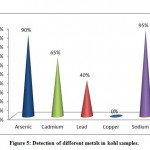 |
Figure 5: Detection of different metals in kohl samples. |
Medicinal Importance of KohlDiscussion
Kohl, generally known as Surma/Kajal in Indo-Pakistan, has been traditionally used since antiquity in most of the Middle and Far-east countries, having a strong cosmetic, medicinal and religious importance. In respect of medicinal importance, Kohl has been widely used for its therapeutic effects against different eye diseases and for the enhancement of eye vision.21 Apart from its beneficial importance, detrimental effects of Kohl have also been reported on human health progressively from last few decades due to the presence of microbial contaminants and presence of heavy metals such as lead, arsenic, copper, cadmium etc.in its composition10.The present study was focused to investigate both beneficial and injurious aspects of Kohl in various branded and non-branded samples, while the brand names are not mentioned to avoid any possible legal complications. The antimicrobial effect of Kohl samples was investigated against microbial pathogens which are usually involved in ocular infections being well recognized as leading cause of conjunctivitis, blepharitis, dacryocystitis, keratitis and endophthalmitis in the previously reported literature.22 The study revealed excellent bioactivity of Kohl samples against most of the bacterial strains particularly P. mirabilis and S. epidermidiswhich confirm previous researches, where Kohl showed good antibacterial effect against Staphylococcus and Proteus species.6 However, previous finings regarding antifungal bioactivity of Kohl is lacking although in the present study many Kohl samples showed antifungal capacity against a number of ocular fungal pathogens. According to current findings, Candida spp.and Mucorspp. were highly inhibited by the Kohl samples. These fungal species are well known ocular pathogens and were recently reported to cause a severe Oculo-rhino-cerebral mucor mycosis in immune-compromised patients.23 Moreover, Candida and Aspergillus species are also found to be associated with fungal keratitis which has been considered as a common ocular mycosis responsible for blindness in most of the cases.24
Microbial Contamination in Kohl Samples
Apart from beneficial importance of Kohl, injurious aspects due to microbial and chemical contamination have also been reported earlier. In current findings, we isolated bacteria and fungi from many Kohl samples. Bacillus and Aspergillus species were found to be the most common contaminants in Kohl samples, which also coincide with a previous study where Kohl, mascara and eyeliner samples were found contaminated with these species.10 These species are present in environment and therefore their contamination might be due to improper packaging or storage of these kohl samples.
Chemical Contamination in Kohl Samples
The heavy metals are non-essential and non-biodegradable elements and can induce toxicity even at very low doses. Presence of heavy metals in cosmetic products has been associated with many health-related issues due to heavy metals toxicity.25 However, these toxic metals are now banned or at least restricted by the concerned regulatory authorities of many countries, though permissible limits of metals might be different in many products with respect to various countries.26 The metal impurities in cosmetic products are usually compared with the standard limits of United States Food & Drug Administration (USFDA) but recently the Federal Office of Consumer Protection and Food Safety of Germany (BVL) has reduced the standard levels and demonstrated new limits for metals content in cosmetic products.20
Arsenic is one of the most lethal heavy metal having the highest rank in the list of risky substances. Its continuous exposure to humans may lead to severe illnesses such as it reduces the synthesis of erythrocytes and leukocytes, developed skin lesions, neurological problems, pulmonary, peripheral, vascular, cardiovascular diseases, diabetes mellitus and certain types of cancers.27 In our study, arsenic metal was detected in 90% of the total Kohl samples and 80% of these samples were detected with high metal content (5.912 ppm) according to BVL published standard limits. These findings correlate with the previous studies in which the arsenic content was detected higher within different cosmetic products.28
Cadmium is biologically a non-essential heavy metal which is well recognized for its adverse influence on the enzymatic systems of cells.29 Our results revealed cadmium metal in 65% of the total Kohl samples, in which 30% samples possessed high level of cadmium (1.430ppm) than standard limits. Another study also reported a little lower concentration of cadmium (0.942 ppm) as compared to our findings.30 Similarly, lead (Pb) is also a non-essential metal, having no nutritional value to living organisms and ranks fifth in the list of metals31. Lead is a recognized carcinogen and its minimal exposure to humans can be very toxic causing severe diseases such as headache, hypertension, arthritis, birth defects, paralysis, brain and kidney damages, and even the death.32,33 Kohl has been reported as one of the major source of lead poisoning mainly in children and it can be absorbed across the conjunctiva by eye rubbing, tearing (lacrimation) while finger licking could further enhance the lead absorption in living systems. Many researchers after laboratory confirmation reported the existence of lead in many Asian Kohls13. An analytical study of different types of Kohls in Pakistan also revealed lead concentration within the range of 0.03% to 81.37%.34 In literature of more than 20 years, many case studies of plumbism (lead poisoning) have been reported, most frequently in infants and children that upon investigation have been attributed to Kohl usage were found with high concentration (199.9 ppm) of lead which is much higher than mandated levels. Another study, however, reported the further higher concentrations (1005 ppm) in Kohl samples.30 Copper is also known to play a vital role in enhancing and strengthening of eye vision and can inhibit activity of lactate dehydrogenase, which is a sensitive marker of cataract formation35. Although this beneficial metalwas not detected in any of our Kohl samples. However, in previous studies, it was detected in high levels from various Kohls. Similarly, another important and beneficial metal Iron was also detected in 95% of the Kohl samples but in very little amount (23.14 ppm) as compared to the previously reported studies.30
Conclusion
Briefly in this study, we observed that most of the Kohl samples possessing antimicrobial potential against ocular pathogens had high contents of heavy metals. While the Kohl samples with lower content of heavy metals exhibited weak or no inhibitory effect against microbial pathogens. Therefore, the antimicrobial activity of Kohl samples might be due to the presence of high contents of heavy metals which are known to produce bactericidal or fungicidal activities since antiquity.36 Furthermore, two Kohl samples, SE16 and SE17 demonstrated excellent antimicrobial effect in the absence of toxic metals in their composition. Therefore, the antimicrobial potential of these Kohl suggested their use in ocular infections. However most of the samples were found contaminated with heavy metals particularly samples: SE1, SE2, SE3, SE4, SE5, SE6, SE14 and SE15 were found heavily contaminated with heavy metals such as Lead, Arsenic and Cadmium and all of these Kohl samples were from very famous brands of Pakistan. It was concluded that detection of high contents of heavy metals such as lead, arsenic and cadmium in most of the Kohl samples suggest proper monitoring of locally manufactured or imported cosmetic products in order to ensure the safety of public health.
Acknowledgement
The authors gratefully acknowledge Lab of Applied Microbiology and Clinical Mycology, Department of Microbiology, FUUAST for the provision of microbial cultures for the study.
Funding Source
The study was partially supported by Higher Education Commission, through NRPU: 4497 awarded to one of the author.
Conflict of Interest
There is no conflict of interest.
References
- Al-Hazzaa SA and Krahn PM. Kohl: a hazardous eye liner. ophthalmology, 1995; 19(2): 83-88.
- Mahmood ZA, Zoha SMS, UsmanGhani K, Hasan MM, Ali O, Jahan S and Zubair M. Kohl (surma): Retrospect and prospect. Pak J Pharm. Sci. 2009; 22(1): 107-122.
- Tapsoba I, Arbault S, Walter P, Amatore C. Finding out Egyptian Gods’ secret using analytical chemistry: Biomedical properties of Egyptian black makeup revealed by amperometry at single cells. Chem., 2009; 82(2):457-460.
- http://www.yursil.com/blog/2007/05/Kohl-Surmah-Lead-Concerns.
- Andalib S, Rizwani GH , Sharif H and Arman M (2018). Chemical and toxicological studies on different brands of Asmad (Antimony sulphide) available in Pakistan and Saudi Arabia. J. Pharm. Sci. 2018; 31(6)(Suppl): pp.2591-2595
- Al-Kaff A, Al-Rajhi A, Tabbara K and El-Yazigi, A.Kohl-the traditional eyeliner: use and analysis. Saudi Med., 1993; 13(1): 26-30.
- Vaishnav R (2001). An example of the toxic potential of traditional eye cosmetics. Ind. J. Pharmacology, 2001; 33: 46-48.
- Ullah PH, Mahmood ZA, Sualeh M, Zoha SMS. Studies on the chemical composition of kohl stone by X-ray diffractometer. Pak J Pharm Sci., 2010; 23: 48-52.
- Mahmood ZA, Azhar A, Ahmed SW. Kohl Use in Antiquity: Effects on the Eye. In: Philip Wexler editor. History of Toxicology and Environmental Health: Toxicology in Antiquity, 2nd, Academic press, 2019; pp. 93-103.
- Tabbara KF and Burd EM. Microbial content of kohl.Ann Saudi Med., 1987;7(3): 177-9.
- Sweha F. Kohl, a long history in medicine and cosmetics. Sci. Med., 1982; 17(2):182-183.
- Lev E. Reconstructed materiamedica of the Medieval and Ottoman al-Sham.” Ethnopharmacology, 2002; 80(2-3):167-179.
- Ali AR, Smales OR and Aslam M. Surma and lead poisoning.”British Med. J., 1987; 2(6142) :915-916.
- Sprinkle RV. Leaded eye cosmetics: a cultural cause of elevated lead levels in children. J Family Practice, 1995; 40(4): 358-363.
- Khalid Q, Ismat M, Sultana L and QadeeruddinM . Studies on the blood lead levels after application of surma to eyes in children and adults. Pak, J. Pharmacol, 1995; 12(2): 37-41.
- Valgas C, Souza SMD, Smânia EF and Smânia JR (2007). Screening methods to determine antibacterial activity of natural products. . J. Microbiol., 2007; 38(2): 369-380.
- Sequeira BJ, Vital MJS, Pohlit AM, PararolsICandCaúper GSB. Antibacterial and antifungal activity of extracts and exudates of the Amazonian medicinal tree Himatanthusarticulatus (Vahl) Woodson (common name: sucuba). Memórias do InstitutoOswaldo Cruz., 2009; 104(4): 659-661.
- Ali A and Naseem F. Frequency distribution of bacteria isolated from different industrial effluents.” Daffodil Int. Uni. J. Sci.Tech., 2012; 7(1) : 28-33.
- Sharma B and Tyagi S. Simplification of metal ion analysis in fresh water samples by atomic absorption spectroscopy for laboratory students.” Lab.Chem.Edu., 2012; 1(3): 54-58.
- Bund BVL.Technically avoidable heavy metal contents in cosmetic products.”J, Cons. Prot. Food Safety, 2017; 12(1):51-53.
- Habibullah P. The Sacred Paraphernalia, belongings of Holy Prophet (Peace Be Upon Him). Educational Press, Pakistan Chowk, Karachi, 2006; pp.191-194.
- Teweldemedhin M, Gebreyesus H, Atsbaha AH, Asgedom SW and Saravanan M. Bacterial profile of ocular infections: a systematic review.” BMC Ophthalmology, 2017; 17(1): 212.
- Pandey D, Agarwal M, Chadha S, Aggarwal D. Mixed opportunistic infection with Mucor, Aspergillus and Candida in oculo-rhino-cerebral mycosis: An uncommon case. Academy Clin. Microbiol., 2019; 21(1):47.
- Kumari R, Jain SB, Ranjan N. Microbiological and epidemiological profile of keratomycosis in a tertiary care hospital–a prospective analysis. J Appl. Res.2019; 9(5): 35-37.
- Jaishankar M, Tseten T, Anbalagan N, Mathew BB and Beeregowda KN. Toxicity, mechanism and health effects of some heavy metals.InterdisciplinaryToxicol., 2014; 7(2), 60-72.
- Bocca B, Pino A, Alimonti A, Forte G. Toxic metals contained in cosmetics: a status report. Toxicol. Pharmacol., 2014; 68(3): 447-467.
- Hopenhayn C. Arsenic in drinking water: impact on human health. Elements, 2006; 2(2) : 103-107.
- Saadatzadeh A, Afzalan S, Zadehdabagh R, Tishezan L, Najafi N, Seyedtabib M, Noori SMA. Determination of heavy metals (lead, cadmium, arsenic, and mercury) in authorized and unauthorized cosmetics. Ocul.Toxicol., 2019; 38(3): 207-211.
- Irfan M, Hayat S, Ahmad A and AlyemeniMN(2013). Soil cadmium enrichment: Allocation and plant physiological manifestations. Saudi J. Biol.Sci., 2013; 20(1): 1-10.
- Ullah, H, Noreen S, Rehman A, Waseem A, Zubair S, Adnan M and Ahmad I. Comparative study of heavy metals content in cosmetic products of different countries marketed in Khyber Pakhtunkhwa, Pakistan. Arabian J. Chem., 2017; 10 (1): 10-18.
- Karrari P, Mehrpour O and Abdollahi M. A systematic review on status of lead pollution and toxicity in Iran; Guidance for preventive measures. DARU J. Pharm. Sci., 2012; 20(1): 20-22.
- Shihata A. 2018. Comparison Study of Toxicity Kohl and Black Stone Hair Dye. J Environ Anal Toxicol 8: 539. doi: 10.4172/2161-0525.1000539
- Debnath B, Singh WS, Manna K. Sources and toxicological effects of lead on human health. Indian J. Med. Spec., 2019; 10: 66-71.
- Rahbar MH, White F,Agboatwalla M, Hozhabri S and Luby S. Factors associated with elevated blood lead concentrations in children in Karachi, Pakistan. Bulletin of the World Health Organization, 2002; 80: 769-775.
- Siddiqui TA, Shadab Z, Nishat I, Ayasha, N., Zehra, Z., &Alavi, S. H. (2003).“Anticataract activity of Kohl-ChikniDawa—a compound ophthalmic formulation of Unani medicine in alloxan-diabetic rats.” Ethnopharmacology, 2003; 86(1):109-112.
- Lemire JA, Harrison JJ and Turner RJ (2013). Antimicrobial activity of metals: mechanisms, molecular targets and applications. Nature Rev. Microbiol., 2013; 11(6): 371-384.

This work is licensed under a Creative Commons Attribution 4.0 International License.





